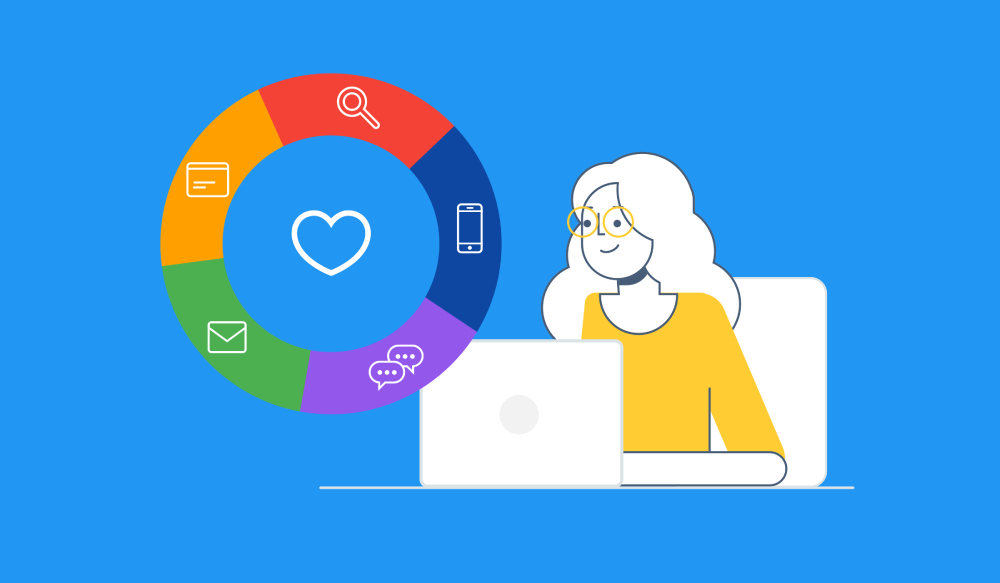Customers now have an unprecedented number of ways in which they can interact with a business. They expect nothing less than perfect experience in each of their interactions with the business. Omnichannel customer experience management ensures that the customer receives the same stellar and seamless experience from the business, regardless of the touchpoint.
- Omnichannel customer experience statistics
- Multichannel vs. omnichannel
- Why is omnichannel customer experience important?
- Insights on building omnichannel experience
- Challenges of omnichannel customer experience
- Omnichannel customer experience examples
FAQs about omnichannel customer experience
Omnichannel customer experience is a unified approach to customer interactions across different contact channels.

Omnichannel customer experience statistics
Here are a few customer experience statistics that show the importance of an omnichannel strategy.
- 66% of customers actively use at least three communication channels to contact businesses (Microsoft)
- 87% of customers think brands need to put more effort into creating a seamless experience. (Zendesk)
- 67% of businesses do not personalize their customer experiences in any way. (Salesforce)
The statistics tell the story: While customers want to see a consistent omnichannel experience tailored to their needs, businesses are not catching up. That means that businesses that are able to provide omnichannel experiences that customers are asking for have a competitive advantage.
Omnichannel vs. multichannel
There’s a little bit of confusion between these two terms: omnichannel and multichannel. While they sound similar, they are not the same thing. Here’s the difference between the two.
Omnichannel- An omnichannel experience means that all customer interactions with your brand are unified. No matter what channel the customer contacts your business from, they can expect the same quality of experience.
Multichannel- A multichannel experience means that your business has multiple channels where a customer can come in contact. However, the experience that customers can expect from these channels may or may not be the same.
So while every omnichannel experience is multichannel, not every multichannel experience is omnichannel. An omnichannel approach means that your customers can expect the same quality no matter how they contact you.
Why is omnichannel experience management important?
Customers will always have questions that they want to be answered. The business is expected to answer these quickly and to their satisfaction and on the channel of their choosing. This would determine if the business will progress to the next stage of the buyer or customer journey. It is, therefore very important to manage the omnichannel experience of your buyers and customers.
Here are 5 key reasons why a business needs to provide omnichannel experience.
- Unified experience – Having an omnichannel focus on managing your customer experience, helps provide a unified experience to the customer. The customer does not know which communication channel is most convenient for your team. When a customer reaches out to a business, he/she just uses the most convenient channel at hand. When the device is switched or a call gets disconnected, they expect to start from where they left off irrespective of the channel they were using earlier.
- Less customer frustration = more revenue – Customers should be able to get their questions answered without jumping through hoops. It just makes their experience that much more enjoyable. A happy customer is loyal and a great source of future sales, upsells, and even referrals and increases your revenue.
- Personalized interactions – When you know who is reaching out and for what, your agents are able to provide more personalized attention to your customer. This personalization comes from having a centralized place for tracking all interactions at the customer level.
- Precious feedback – When customers interact with your agents, they are sharing critical information about themselves. In their process of evaluation, they also may tell you what they like and do not like in your products. All this data is gold.
- Improved business performance – Knowledge is power. You can collect a lot of customer behavior information with measurement metrics at each customer touchpoint. This will help you understand your customer needs better. This also helps you to improve your business performance on an ongoing basis.
Insights on building omnichannel customer experience
Here’s what you need to know about building omnichannel customer experience.
Omnichannel customer experience is expected
The days when every customer was going to contact you through 1-2 channels are over. Customers expect maximum convenience, whether they’re contacting you through website chat, email, phone calls, text messages, or Facebook Messenger.
Integrate data into every touchpoint
The companies that win are those that incorporate data in order to measure customer experience and get a better understanding of their customers. By taking customer surveys, businesses can understand what’s motivating customers to complete or not complete the customer journey. This, in turn, can help you improve your operations and help you build a superior customer experience.
Eliminate friction
The words “omnichannel customer experience” do not mean anything to your customers. What they care about is that they have a seamless experience. It means that if they start a conversation on text and then move to website chat or Facebook, your team will be able to follow through from beginning to end and provide the same level of service at each step.
4 steps to building an omnichannel customer experience
Today’s consumers have a variety of options when it comes to engaging with your brand. They can physically check the product at your store or can evaluate it online. In the process of determining whether or not the product suits their needs, they can interact with the business in several ways. At each touchpoint, they have an opportunity to ask questions and move further along in their buyer’s journey.
Every business, therefore, needs to create a solid omnichannel customer experience management strategy to manage their customer interactions. Here are a few easy steps to create a strategy to help you monitor and manage customer experiences better.
Here are a few easy steps to create a strategy to help you monitor and better manage customer experiences.
- Identify customer touchpoints
The buyer’s journey itself is becoming complex by the day. It is therefore important for a business to identify all the touchpoints that its customers can possibly interact with. - Listen to customer feedback
Improving your customer experience means that you have to see how customers are rating their interactions with you. Send surveys to determine satisfaction and keep a close eye on your customer reviews. - Identify where your current experience is fragmented
Customer experience is constantly evolving and it’s important to identify where your gaps may lie. A few years ago, almost no business offered website chat. Now, 79% of customers say website chat is their preferred channel. It’s important that you’re making sure that your customer experience is keeping up with changing trends while also aligning with the rest of your channels. - Invest in a experience marketing platform
Make sure all your interactions are tracked and stored in a central place. Experience Marketing platforms like Birdeye allow you to manage all customer feedback in one central dashboard. Communicate with your website visitors, send and receive text messages on their messages, answer questions on the go and even manage the social interactions from Facebook messenger – all from one place.
Challenges of omnichannel experience management
Although the decision to implement an omnichannel customer experience strategy is a no-brainer, it does have some challenges. Here are a few.
Challenge #1: Overcoming data Silos
Traditionally, businesses have channels that are aligned with specific business units. Data is usually collected at the business unit level and is isolated. Management of that data is done individually in the silos, and not across the board. To get 360-degree visibility into the customer, all the data needs to be blended and used by all business units.
Challenge #2: Getting the personalization right
It is important to recognize the person that the business is interacting with. Once you know the identity of the person by matching it with the database, you can understand what their history has been. This will help you provide the personalized service that is expected of your business. Problems may occur when information gets lost as the customer moves from channel to channel. A professional customer experience platform can help with this.
Challenge #3: Getting humans and technology to work together
You have a great strategy in place. However, your people at each touchpoint may not be trained to use the power they have been handed. When this happens, data may not be collected in the format that would be useful for everyone in the business.
Omnichannel customer experience examples
Let’s talk about a few successful companies that have adopted an omnichannel strategy.
Disney
Disney is a giant company with properties like theme parks all over the globe. Even with this gigantic media empire, the company makes an effort to ensure that customers can expect the same quality experience no matter where they go.
The My Disney Experience mobile app and desktop allow you to plan your family’s next trip to a Disney theme park. Not only can you book a hotel, you can also book a room and even your meal. It makes the whole experience of going to Disneyland more convenient and consistent.
Echo Wireless
You don’t need to run an international media empire in order to provide a great customer experience. With the right software, any business can provide it. Consider Echo Wireless, an Internet Service Provider based in Brownwood, Texas.
Echo Wireless has separate teams for tech support, sales, and billings, with different teams for each channel. The business wanted to simplify its customer interactions and turned to Birdeye. With the help of Birdeye, Echo Wireless is now able to look at all customer interactions in one place. All of its different communications teams were consolidated into one, helping the business stay on top of all customer messages and helping customers have a seamless experience.
Be the best with Birdeye
Create an omnichannel customer experience with Birdeye. Birdeye gives you the tools to collect data on customers through customer surveys and online review monitoring. Birdeye’s award-winning webchat allows you to connect and engage with website visitors and customers.

Originally published









